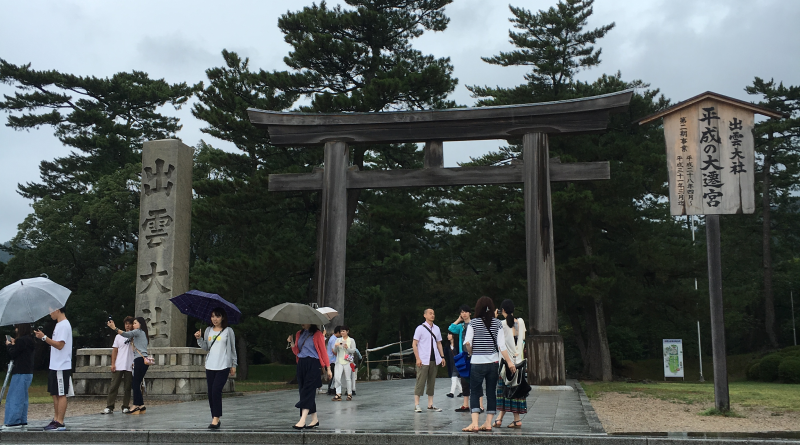
Izumo Taisha: Meeting Place of The Gods
Finally! After all that mythology, we are finally ready to go to Izumo! This is a place we have really been looking forward to going to. Why? Because Izumo is the land of the gods! The Kojiki is largely a work of fiction. I say largely only because the closer you get to the end of it, the less it deals with the adventures of Japanese gods, and the more it starts talking about actual events. It is not unusual then for real cities, which still exist and thrive, to be mentioned in the text. One of the most significant of these places is Izumo Oyashiro, or as it more commonly known, Izumo Taisha.
Getting To Izumo Taisha
We only had a three day weekend to go to Izumo and we had a lot of things we wanted to do, not just in Izumo, but Matsue city and the surrounding area. Because our time frame was a little restricted, we decided to save ourselves a little bit of trouble and took the Shinkansen from Shin-Osaka changing lines once in Okayama to the Ltd Exp service bound for Izumo-shi in Shimane.
The landscape from Osaka to Izumo was pretty hilly. After you change lines in Okayama, the geography gets fairly mountainous, making the train ride almost like a rollercoaster, as it climbs up and through mountains. In fact, this train is notorious for giving people motion sickness.

The city of Izumo may not seem like all that much—it’s in the far away prefecture of Shimane, transportation to and around Izumo is not as frequent or convenient as many other tourist destinations in Japan. The nearby capital of Matsue, while a big city, can seem small when compared to other large capitals in Japan, such as Osaka, Tokyo, or even Fukuoka City.
Once you arrive in Izumo-shi Stn. there is a bus available for Izumo Taisha about every half hour and costs 520 yen. There is also a train from Izumo-Shi Stn to Izumo Taisha Stn, but the train only runs once an hour.
Quite unfortunately for us, on the very first day of our trip a huge storm cell decided to sit right on top of Izumo city. Of course we forgot to look at the weather until we were well past Okayama with no hope at all of finding an umbrella. Moral of the story: always check the weather.
The Mythology of Izumo Taisha
According to myth, Izumo Taisha enshrines Okuninushi-no-mikoto, the god who ruled Japan until the first decedent of Amaterasu appeared ergo eventually beginning the royal bloodline. This makes it one of the most important shrines in Shinto, out ranked only by Ise Jingu, where Amaterasu is enshrined. It is also the oldest known shrine in Japan, as parts of the main shrine has been dated to be somewhere around 1500 years old.
In addition, according to the old Japanese calendar October is kannazugi [神無月], the month of “No Gods”. Why are there no gods? Because they are all in Izumo Taisha. Once a year, all the gods from all over Japan as said to travel to Izumo Taisha where, led by Okuninushi-no-mikoto, they will sit and discuss the fates of man, or En-musubi, for the coming year. En-musubi refers to the bonds and destinies that connect all people such as who will meet who, which friends will part ways, and which lovers will meet. Because of the significance En-musubi has with human relationships, and the fact that Okuni had many wives and lovers, Izumo Taisha is now a popular destination for people to pray for marriage though he isn’t the god of marriage. With Japan’s ever dwindling birthrate a constant problem for the future of their society, I guess every little bit helps?

Shrine Grounds
While other shrines will only ask you to purify yourself by washing your hands before entering the shine, Izumo Taisha has a two-step process. After passing through the wooden torii, there is a small shrine called harae no yashiro [祓社] where visitors are supposed to pray for spiritual cleansing before continuing to the inner shrine grounds. Once you are closer to the actual shrine, you will wash your hands as usual.

After you have purified yourself, head down the path where you will quickly notice another large torii. There are a total of three torii in Izumo Taisha, one of bronze, one of wood, and one of iron. There is a fourth one made of cement at the end of the shopping street right in front of the entrance to the shrine, but it is not connected to the shrine.
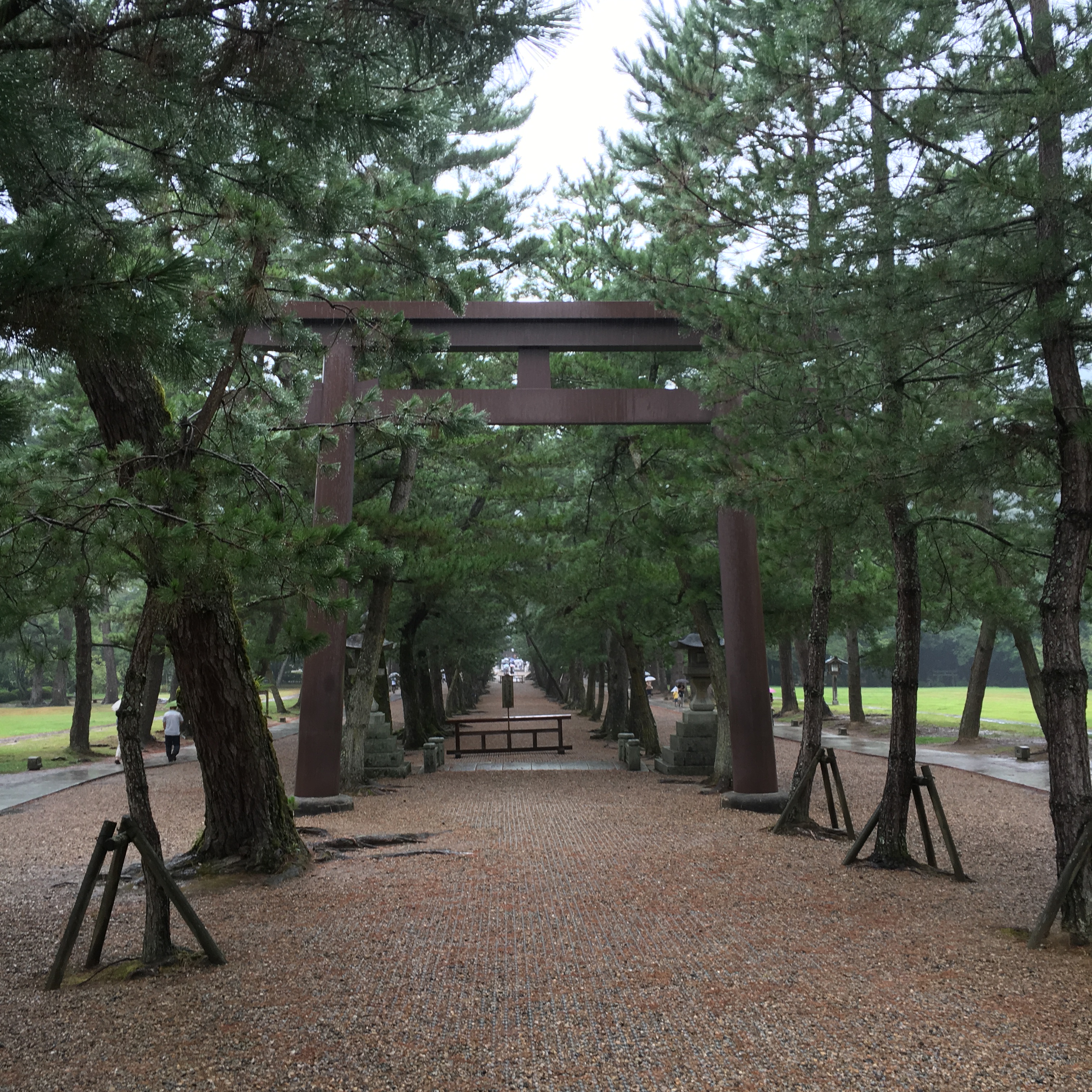

Also one the path toward the main shrine, you will soon notice that there is a strong rabbit theme around the shrine. This of course is to honor the Hare of Inaba and his role in helping Okuni.


Shimenawa
The very striking ropes that decorate Izumo Taisha are called shimenawa [注連縄], are very iconic and some of the largest in Japan. In fact, Izumo Taisha’s kaguraden has the largest shimenawa in Japan.
You might see a lot of coins embedded in the shimenawa at Izumo. Visitors threw these coins in to shimenawa in hopes of receiving good fortune. Ironically, due to the high number of tourist, those very coins are actually destroying the shimenawa. Izumo Taisha’s website even specifically asks its visitors to cease this practice, so don’t do it. Even if you see Japanese people doing it, don’t.
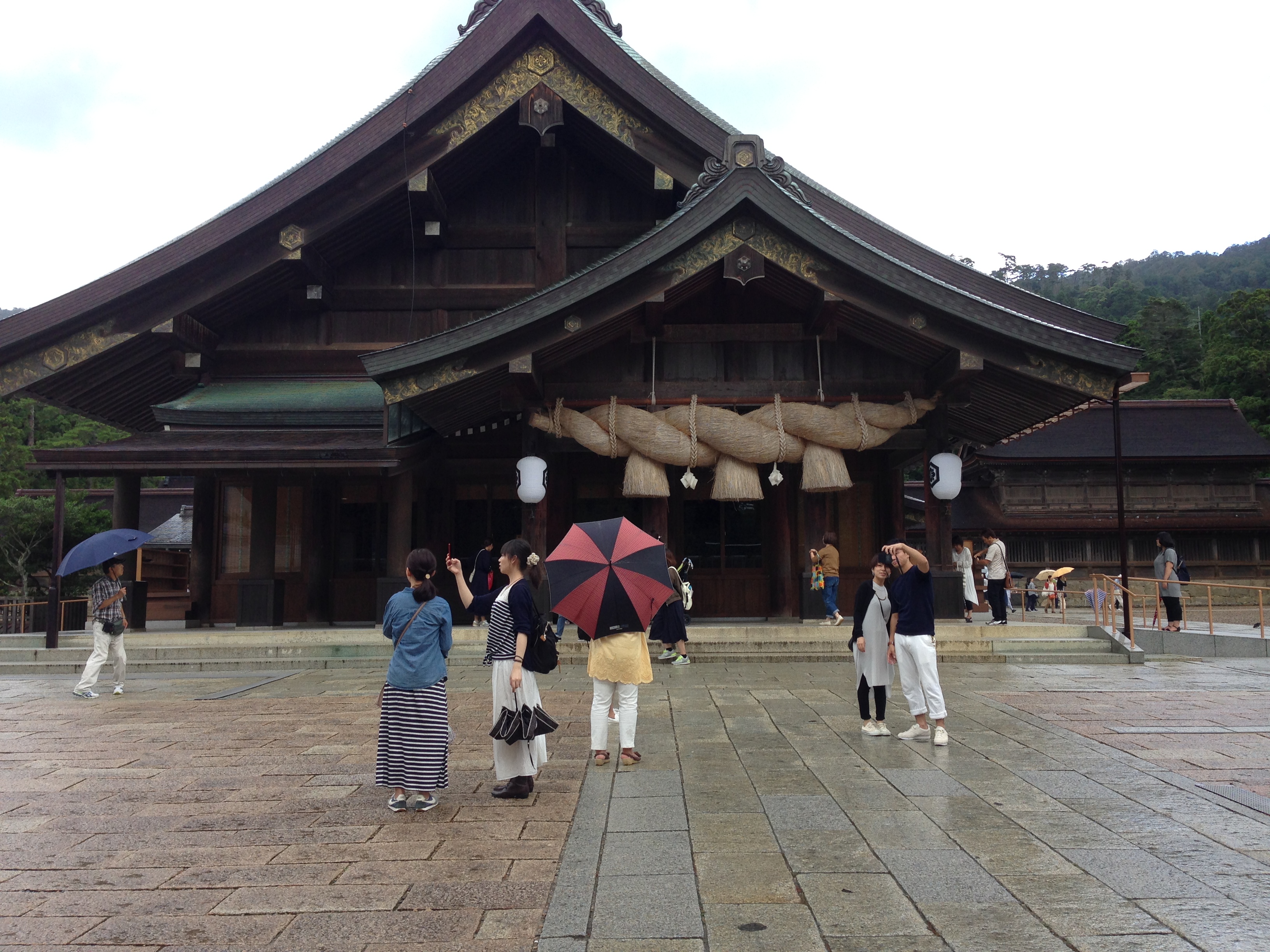

Praying at Izumo Taisha
When approaching a shrine to pray, there is a customary sequence of:
- Bow twice,
- Clap twice,
- Pray,
- Bow.
Izumo Taisha however, is a little different. In Izumo Taisha it’s:
- Bow twice,
- Clap four times,
- Pray,
- Bow.

Why the Extra Clapping?
We asked a priest to explain why it is different, but his answer was a little vague. He said they clap eight times on special days and festivals, so it’s just half for regular days. In Japan, the number eight often has something to do with eternity, so that is possible too. I’ve seen in a number of different places that say that the additional clapping is for the person’s partner. This clapping ritual, however, is centuries old and Izumo Taisha being considered a couple’s spot has only been around for about twenty years, so I tend to be skeptical of any answers that talk about lovers.
Izumo Taisha’s Honden [Japanese National Treasure]

The main shrine or honden [本殿] of Izumo Taisha is the oldest part of the shrine, and is a Japanese national treasure. The Kojiki states that Izumo Taisha predates the arrival of Japan’s mythical first emperor, Emperor Jimmu. It also says that at one time the honden was an impressive 48 meters tall. While the arrival of Jimmu is rather iffy, there is archaeological evidence to support the claim that the honden was once 48 meters high. Excavation in the inner part of the main shrine uncovered the remains of three large poles. It is possible that these poles could have formed one large support pillar, suggesting something much larger once stood there. If the original structure was indeed that tall, it is likely that overtime it simply became too heavy and collapsed.
The Izumo region is also prone to heavy snow fall in the winter, so it is likely that the snow contributed to wood rot, which could have also further weakened the support beams. Furtehrmore, from the Heian Period to the Kamakura Era, Izumo Taisha reportedly toppled over seven times. The current structure today stands just around 25 meters and was completed in 1744.
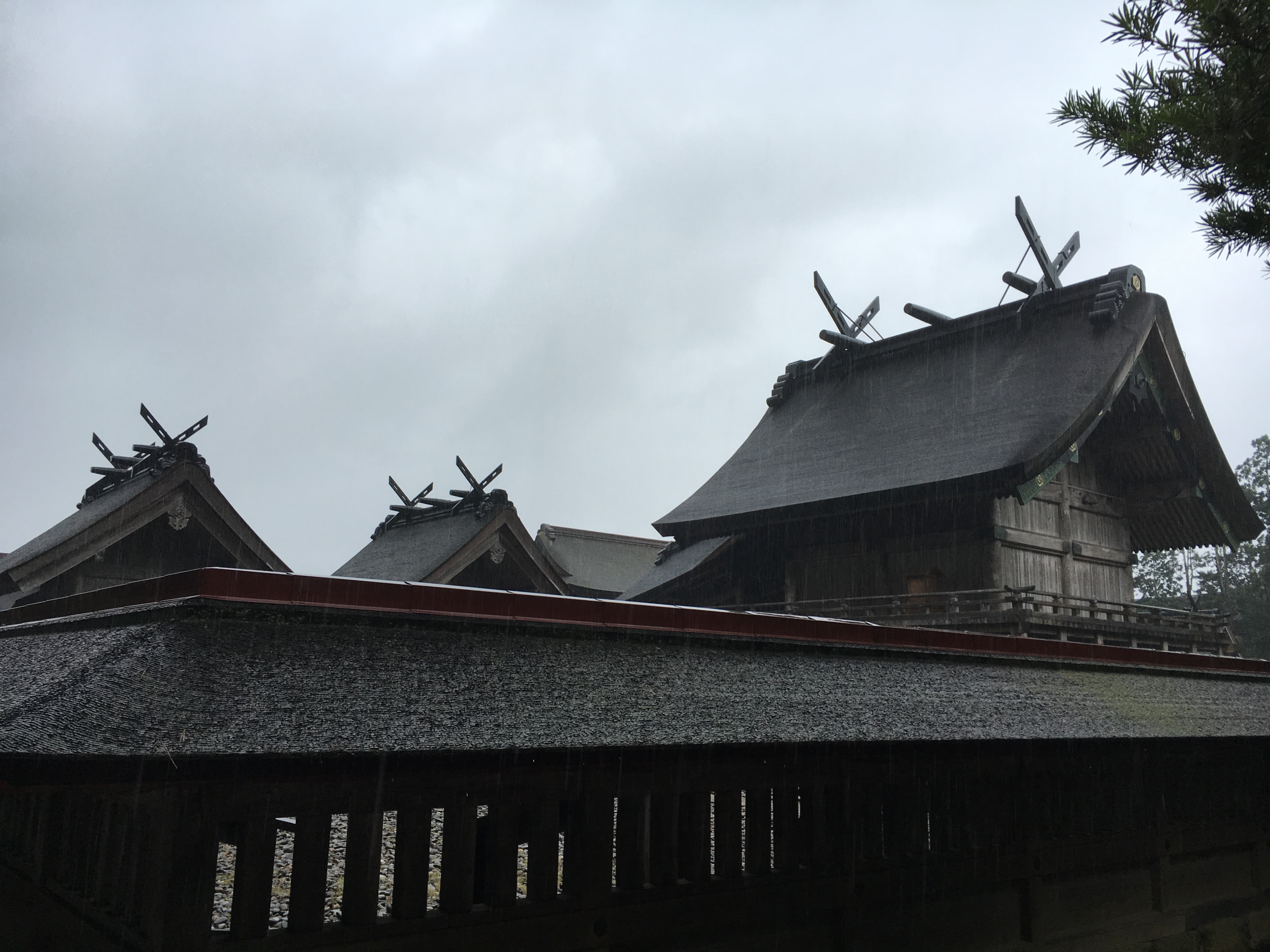
Architecture
Izumo Taisha is indeed old, but what makes it a national treasure is the unique architectural style, taisha-zukuri, or ooyashiro-zukuri. Taisha-zukuri is characterized by an elevated honden with an offset entrance. Meanwhile the inside of the honden is perfectly square with a large central pillar, along with four other smaller pillars on each wall. (You can actually see one of the smaller pillars in the picture above). Because the honden is elevated, archaeologists believe that this structure is based on ancient Japanese dwellings. As you might imagine, taisha-zukuri is not common, and is limited to the Sanin region.
There is so much to say about Izumo Taisha! We’ve only begun to scratch the surface. Now if only the rain would stop…

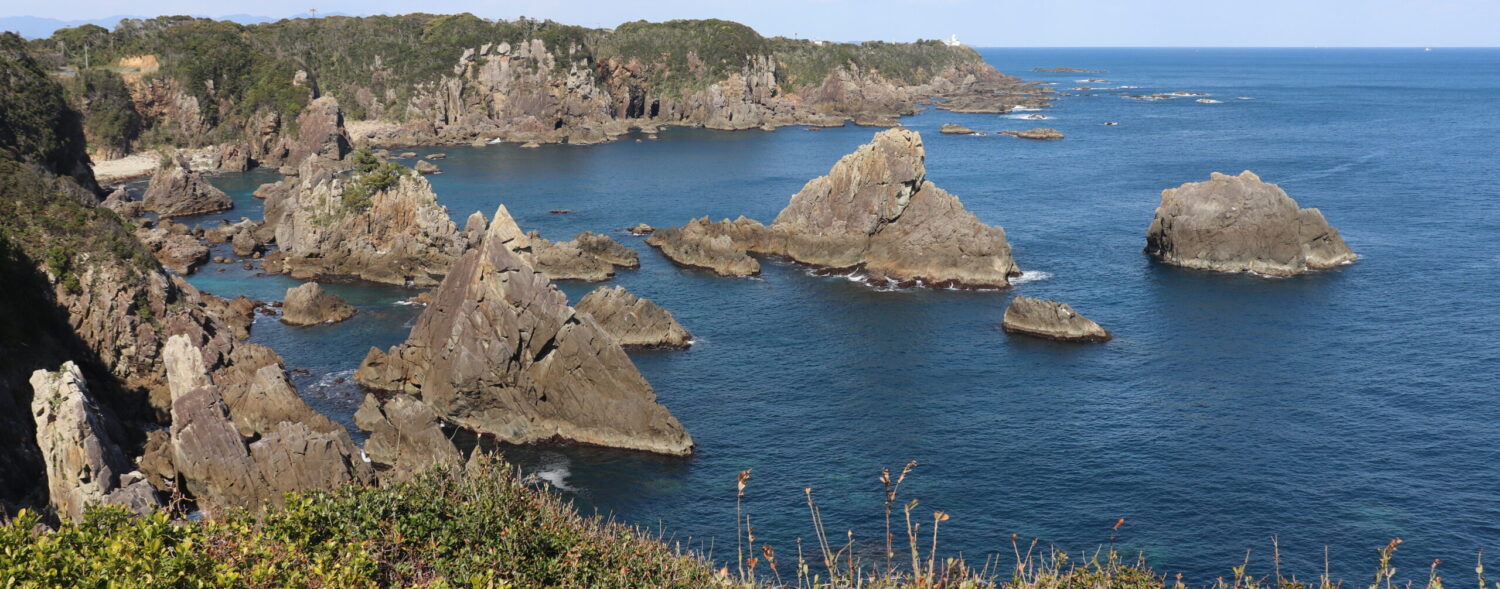
Leave a Reply